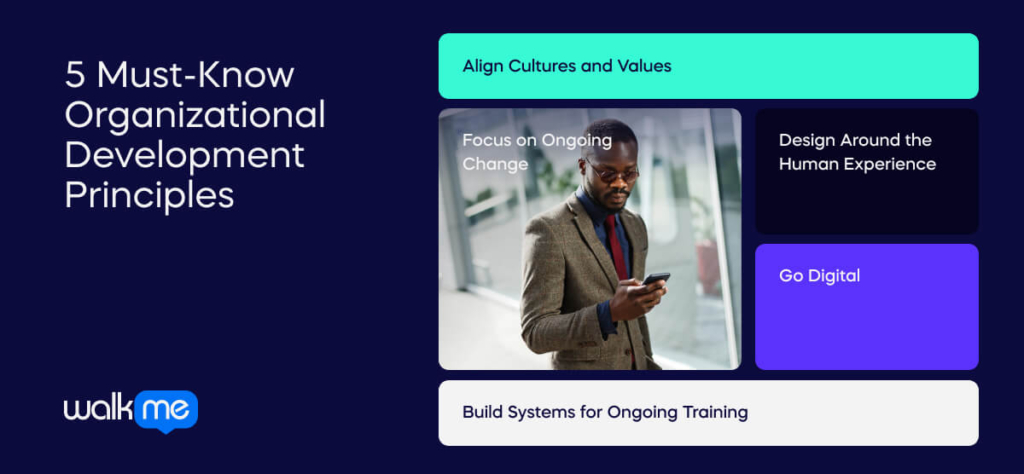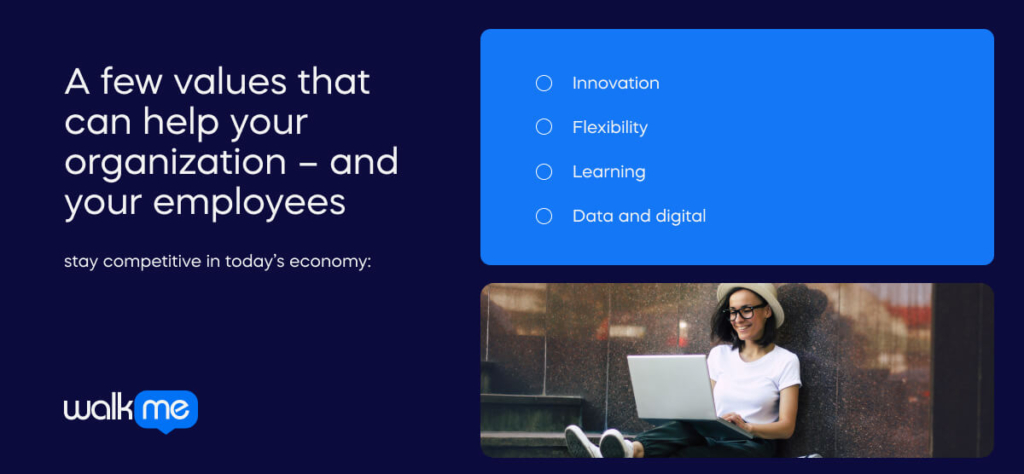What are some of the best organizational development principles?
In this article, we will cover 5 principles that can help you:
- Get better results from your organizational development programs
- Design human-centric programs that get more support from employees, executives, and everyone in between
- Stay effective, as well as cost-efficient
- Build programs that will keep you successful in today’s fast-paced digital age
Among other things.
Knowing these principles will benefit change managers, human resources professionals, and any other business professionals involved in change.
5 Must-Know Organizational Development Principles

The principles below apply equally to long-term organizational development programs, as well as short-term organizational change projects.
1. Align Cultures and Values
Your organization’s mission and values should align closely with your company culture.
The right culture will help you attract the right talent, retain employees longer, improve the employee experience, and maintain peak productivity – to name a few things.
Here are a few values that can help your organization – and your employees – stay competitive in today’s economy:

- Innovation. An innovative business welcomes new ideas, new products, and new solutions – wherever they come from. They support change and new concepts, a key trait for successful organizational development.
- Flexibility. Flexibility, dexterity, and adaptability help a business stay resilient. Companies that can’t react well will have a harder time dealing with digital disruption and other external changes.
- Learning. A culture built around learning will be more relevant, up-to-date, and productive. Because new digital tools are released daily, learning should be a key trait for any modern business.
- Data and digital. Digital literacy, dexterity, and fluency should also be key traits for a business and its workers. After all, today’s economy is becoming more digital by the day.
Naturally, not every company will have the same culture. Nor should they.
Instead, you should focus first and foremost on alignment.
Aligning corporate culture with the organization’s mission will go a long way towards improving the workplace experience – and worker satisfaction.
2. Focus on Ongoing Change
Digital disruption is a common theme in many of today’s change management programs.
And these disruptions are bringing about continual change.
Here are a few areas to focus on if you want a business that can stay adaptable in such an environment:
- Agile business processes. Agile business processes are built to be collaborative and responsive. Software developers, managers, and others have adopted agile methods because they are more suited to a marketplace that keeps changing.
- Advanced enterprise change management. To keep up with constant change, advanced change capabilities are a must. Effective enterprise change management delivers organizational changes faster, more affordably, and more effectively.
- Digitally-driven change programs. Data offers insights. And digital tools drive efficiency. The right change management tools – such as project management tools or digital adoption platforms – fuel effective, efficient change programs.
However, tools and processes aren’t everything … employees still operate businesses.
This is why it’s important to build businesses around humans themselves, not technology.
3. Design Around the Human Experience
The human experience includes:
- Employees
- Customers
- Partners
- Managers
Ultimately, the right experience will streamline operations across a number of areas.
Workers will be more productive. Customers will spend more. Managers will be more cooperative. And so on.
4. Build Systems for Ongoing Training
Lifelong learning is becoming the norm.
To stay relevant and competitive, workers must continually study, learn, and adapt to the changing business environment.
And this environment also carries implications for businesses.
They need to build systems that help attract, retain, train, and upskill their own workforce.
Organizations should strongly consider implementing:
- Career development programs. Career development programs can include mentorship programs, continuing education programs, and more. Programs such as these help employees stay productive, on the one hand. On the other, they incentivize employees to stay longer.
- Reskilling and upskilling programs. Employee training programs, such as software training, help employees gain the skills they need to perform. As with long-term career development programs, education and skills training solutions keep employees productive, satisfied, and relevant. And, as a consequence, the organization stays more productive and relevant.
- Digital training tools. Your choice of digital training tools makes a significant difference in worker competence, productivity, and adaptability. Cutting-edge training tools, such as digital adoption solutions, offer immediate, real-time training. This drastically reduces training time and costs.
Over the long term, such programs will help an organization’s workforce stay relevant, competitive, and productive.
5. Go Digital
Finally, organizations should become fully digital.
A fully digitized organization will have:
- The right technology
- Educated, skilled employees
- Effective digital adoption processes
- A digital culture
To name a few.
In today’s digital world, digital transformation is not an option – it is a prerequisite for success.
Organizational development professionals are in a key position to influence an organization over the long term.
Applying the principles mentioned here can help an organization stay modern, competitive, and relevant in the coming years.

